Joints exist to allow movement between adjacent bones. The ends of the bones are capped with cartilage which is a highly sophisticated weight bearing material. The joint is enclosed in a bag, or capsule, and the capsule is lined on the inside with specialised tissue known as synovium. The synovium produces fluid which lubricates the joint, contributing to its low-wear properties.
Joints have an intricate design in which the cartilage and underlying bone together absorb the large loads that are transmitted across their surfaces — three times body weight at the hip with walking and up to seven times body weight when running and going up stairs.
The surface of the cartilage is extremely smooth and promotes gliding with minimal resistance.
Stability is conferred by the shape of the bone ends, the labrum (the surrounding lip), the capsule, the ligaments and the action of the muscles.
Any damage to the cartilage or underlying bone may lead to arthritis.


